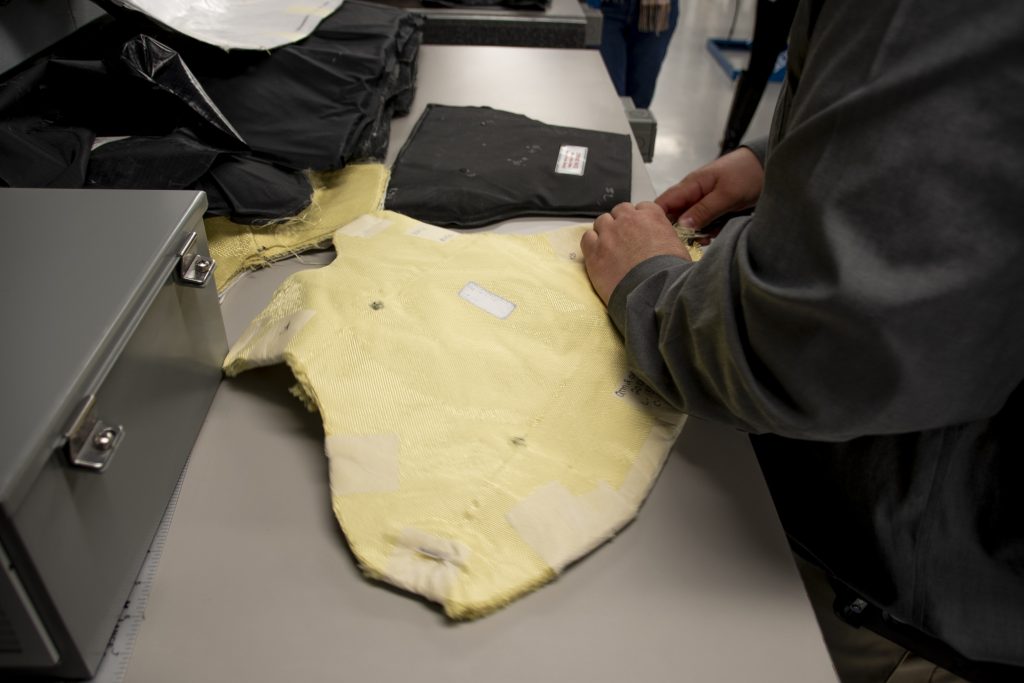
Features
Active shooter preparation & best practices in the world of equipment
Active shooter incidents are dynamic (typically lasting 10-15 minutes) and may vary significantly from one attack to another. Most often these events involve deadly physical force perpetrated by an individual(s) against victims in a confined space or populated area. In the majority of cases, active shooters use firearms and there is no pattern or method to selecting their victims.
November 15, 2018 By Frank Cappo
 A ballistic panel undergoes testing during research and development stages at Armor Express.
A ballistic panel undergoes testing during research and development stages at Armor Express. Sadly, we see all too often the global news headlines on active shooter events and the tremendous risks and sacrifices made by law enforcement officers and first responders when duty calls. The 2014 shooting of a reserve army corporal in Ottawa, the 2017 Quebec City mosque shooting and the van attack earlier this year in Toronto are some recent examples in Canada. And just south of the border, the U.S. has experienced its own tragic events, including the deadly ambush in Dallas, Texas and the Mandalay Bay shooting in Las Vegas. A key lesson learned from all the tragedies is that preparation and application of best practices are crucial for those who are sworn to protect and serve the public.
Though protocols may differ regionally, there are standard approaches that should be considered for the efficient and effective response to mass-casualty incidents. Two of the critical components are evidence-based active shooter training and innovative protection equipment designed to safeguard law enforcement officers and first responders. Failing to prepare and having certain action plans in place can mean the difference between life and death.
As agencies ramp up their strategic training programs to help officers enhance their skills, they’re also very focused on equipping their men and women with advanced body armour such as ballistic vests and other tactical gear including helmets, hard armour plates and shields. This equipment enables officers to quickly engage an armed individual and address the threat while being protected. Today’s high-tech armour solutions are capable of stopping high-powered weapons, which, according to a study published in the Journal of the American Medical Association, were used in about 25 per cent of active shooter incidents in the U.S. from 2000-2017.
In helping to drive agency adoption, body armour makers are increasingly researching and developing equipment that can meet mission-critical needs. These include state-of-the-art concealable, overt and tactical carriers, which provide greater coverage, flexibility and comfort; ballistic and non-ballistic helmets that offer extreme stopping power and lightweight benefits; as well as ceramic and steel plates designed for rapid up-armouring and capable of withstanding today’s rifle round threats (an officer can quickly adjust the protective capabilities of their soft armour/concealable or overt vest).
Ground-breaking solutions are available today, which provide better protection than ever before. Law enforcement departments should carefully consider these as part of their comprehensive emergency response protocol.
Ballistic carriers that meet the demand for speed and adaptability:
These offer patrol officers and task forces the ability to rapidly don and doff, as well as tremendous maneuverability and scalability. The latest overt carriers provide an extremely light, low-drag and durable option, and are designed to fit most hard armour plates and soft ballistic plate backers.
Hard armour plates and ballistic helmets that deliver stopping power, modular and lightweight protection:
Advanced, special-threats tested hard armour plates provide the most robust protection against high-velocity ammunition and can be used in conjunction with soft armour or as a stand-alone. Made from the world’s strongest and lightest materials, new-generation plates offer extraordinary ballistic resistance and flexibility for any encounter.
In addition, innovative ballistic helmets bring first-rate protection to law enforcement, anti-terror and specialized police units who may be exposed to close quarter combat and a greater risk for being shot within the head region. They deliver scalable, high-level impact protection, ventilation and comfort.
Breakthrough protection leads the way now and into the future:
Focusing on the up-armour concept, the most effective “Active Shooter Kits” comprise a complete solution set that enables officers to immediately and easily upgrade their protection when a threat situation escalates. The industry is in an exciting period of game-changing body armour technologies and designs that bring significantly lighter weight, stronger, more multi-threat solutions needed to keep our first responders safe when duty calls. Not to mention, more cost-sensitive options for departments, many of which operate with modest budgets.
Learn more by viewing the recent free webinar on first responders preparing together for active threats hosted by Blue Line, Canadian Security and Fire Fighting in Canada. Watch it now at: www.blueline.ca/webinars/active-threats-are-you-prepared-webinar-5574.
Frank Cappo has close to a 20-year career in the body armour, protective solutions and public safety industry. He spent 12 years as a police officer in Overland Park, Kan., working in patrol, SWAT and in other positions. Cappo now leads Armor Express’ domestic and international sales efforts, responsible for the law enforcement, corrections, fire & EMS, private security, and federal market segments.
Print this page